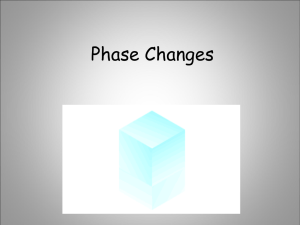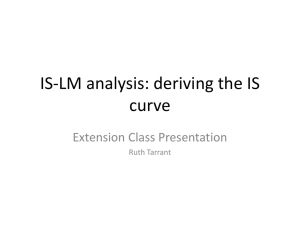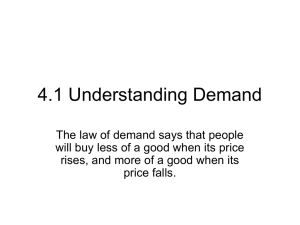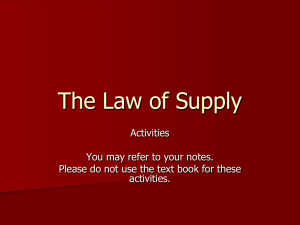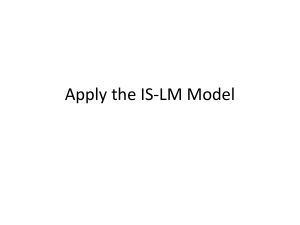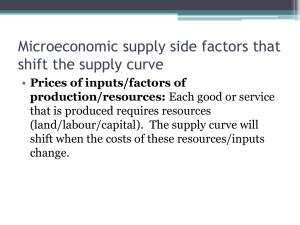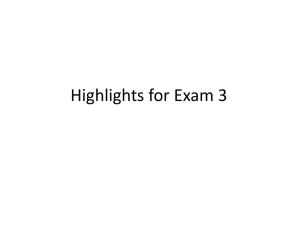ECON 101 Tutorial: Week 1
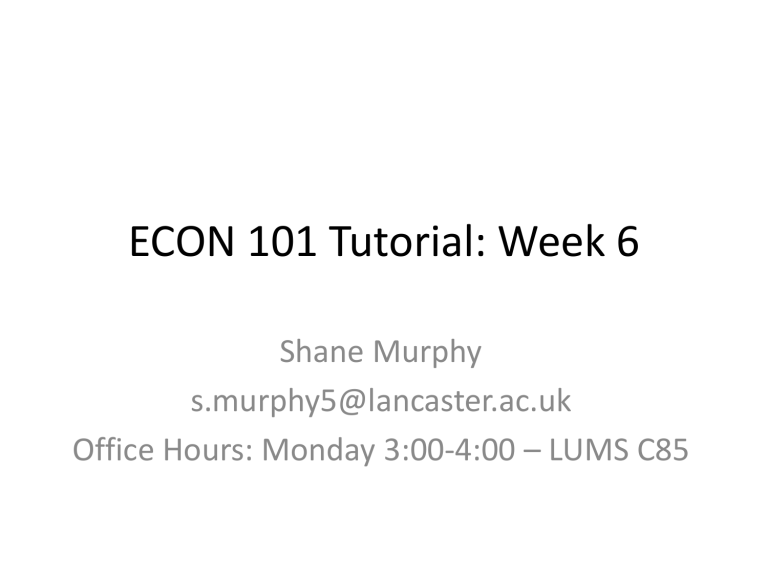
ECON 101 Tutorial: Week 6
Shane Murphy s.murphy5@lancaster.ac.uk
Office Hours: Monday 3:00-4:00 – LUMS C85
LUMS Maths and Stats Help (MASH)
Centre
Are you mystified by maths? Stuck with statistics? The LUMS Maths and Stats Help
(MASH) Centre for LUMS undergraduate students opens this week. Every Monday (16.00-
18.00) and Friday (10.00-12.00), you can drop-in to LUMS B38a or book an appointment to see a student mentor and get help with maths and stats
• Roll Call
• Problems
• Discussion
• Bonus
Outline
Chapter 14: Exercise 1
a) From the following Table, what quantity would a profit maximizing publisher choose? What price would it charge? What would be the profit?
b) Compute marginal revenue, how does MR relate to price?
Chapter 14: Exercise 1
c) Graph MR, MC, and demand. At what quantity does MR and MC cross? What does that signify?
d) Shade deadweight loss. What does this mean?
Chapter 14: Exercise 1
e) If the author were paid 3 million instead of 2 million, how would this change the publisher’s decision regarding the price?
f) Suppose the publisher was concerned with maximizing economic efficiency rather than profit.
What would it now charge? What would be its new profit?
Chapter 15: Exercise 3
Suppose the Eau de Jeunesse Water Company has a monopoly on bottled water in France. If the price of tap water increases, what is the change in Eau de
Jeaunesse’s profit-maximizing levels of output, price and profit? Explain in words and with a graph.
Chapter 15: Exercise 5
a) If the company builds the bridge, what would be its profitmaximizing price? Would that be the efficient level of output? Why or why not?
b) If the company is interested in maximizing profit, should it build the bridge? What would be its profit/loss if it built the bridge?
c) If the government built the bridge, what should it charge?
d) Should the government build the bridge? Why?
Chapter 15: Exercise 9
Explain why a monopolist will always produce a quantity at which the demand curve is elastic.
Discussion
• "The Partridge Family were neither partridges, nor a family. Discuss.“
• "Milli Vanilli is neither a Milli or a Vanilli. Discuss.“
• "Palmolive – it's neither palm, nor olive. Discuss.“
• "Grape-Nuts – it contains neither grapes, nor nuts. Discuss.“
• "The Civil War was neither civil nor a war. Discuss.“
• "The radical reconstruction of the South after the Civil War was neither radical nor a reconstruction. Discuss.“
• "The Holy Roman Empire was neither holy nor Roman nor an empire. Discuss.“
• "The peanut is neither a pea nor a nut. Discuss.“
• "Ralph Fiennes is spelled neither rafe nor fines. Discuss.“
• "Duran Duran is neither a Duran nor a Duran. Discuss.“
• "Rhode Island is neither a road nor is it an island. Discuss."
Discussion
• "The Thighmaster is neither a thigh nor a master. Discuss.“
• "The Progressive Era was neither progressive nor an era. Discuss.“
• "Did Truman drop the bomb on the Japanese to end the war or to scare the hell out of the Russians? Discuss.“
• "The Mormon Tabernacle Choir is neither Mormon nor a tabernacle nor a choir.
Discuss.“
• "The New Deal was neither new nor was it a deal. Discuss.“
• "The chickpea is neither a chick nor a pea. Discuss.“
• "Transitional Romanesque architecture was neither transitional nor Romanesque.
Discuss.“
• "The internal combustion engine was neither internal nor combustion. Discuss.“
• "The jelly bean is neither made of jelly nor is it a bean. Discuss.“
• "The Italian neo realist movement in film was neither Italian nor neo nor particularly realist. Discuss"
If an indifference curve is smooth and convex to the origin, then:
a) The two goods are said to be convex combinations of each other b) There is a diminishing marginal rate of substitution c) The indifference curve is said to be normal d) None of the above
Q5
From Tutorial 4 worksheet: Question 1
Assuming an indifference curve which is convex to the origin, what can this tell us about a consumer’s marginal rate of substitution between coffee and muffins?
A profit maximizing firm would like to produce at least the number of units which minimises short run:
a) Average total cost b) Average fixed cost c) Average variable cost d) Marginal cost
Note: A profit-maximizing firm produces at the efficient scale: the quantity of output that minimizes ATC. We can find this quantity where MC = ATC.
Q18
Long Run Exit Condition
• In the long run, firms will continue if there is a profit, so the exit condition is:
Profit < 0
TR – TC < 0
TR < TC
AR < ATC
P < ATC
Short Run Exit Condition
• In the short run, fixed costs are sunk costs and firms will run if there is greater profit from continuing than from exiting. The firm pays the fixed cost whether it continues or exits the market, so the exit condition is:
TR – (VC+FC) < -FC
TR-VC-FC < -FC
TR – VC < 0
TR < VC
AR < AVC
P < AVC
• So a firm’s short run exit condition is P < AVC
• Since a firms supply curve is equal to its
Marginal Cost Curve, and since MC = AVC at the minimum of AVC, if
Q is less than the quantity that minimizes
AVC, P will be less than
AVC for that Q.
P, C
0
MC=S
AVC q
Suppose demand curve written
D=120-2P, and the supply curve is
S=20+2P. What is the equilibrium price and quantity?
a) P*=70 and Q*=25 b) P*=25 and Q*=70 c) P*=50 and Q*=35 d) P*=35 and Q*=50
Note: Set the two equations equal to each other and solve for P. Plug that value back in to either equation to solve for Q.
Q22
Suppose a product has a demand curve written D = 120 – 2P, and the supply curve is S = 20 + 2P. What is the equilibrium price and quantity.
Equilibrium occurs where D = S, i.e.
120 – 2P = 20 + 2P
100 = 4P
P = 25
Then, substitute P = 25 into either the D or S equation:
D = 120 – 2 * 25 = 70 or
S = 20 + 2*25 = 70 a. P* = 70 and Q* = 25 b. P* = 25 and Q* = 70 c. P* = 50 and Q* = 35 d. Q* = 35 and P* = 50
Suppose demand is given by D=120-2P and supply is originally S=20+2P but the government imposes a tax of 10 on this good. What happens to the equilibrium price?
a) Rises by 10 b) Rises by 8 c) Rises by 5 d) Rises, but it’s not possible to say by how much
Q23
We have D=120-2P and S=20+2P
Then a tax of 10 is imposed on this good.
What happens to the equilibrium price?
There are two ways we can solve this.
1. By assuming that the tax is placed on consumers, thus affecting the Demand curve
(shifting it to the left)
2. By assuming that the tax is placed on suppliers/sellers, thus affecting the Supply curve
(shifting it to the left).
I’ll work through both methods in the following slides.
We have D=120-2P and S=20+2P
Then a tax of 10 is imposed on this good.
By assuming that the tax is placed on consumers, thus affecting the Demand curve (shifting it to the left)
The new demand curve can be written as:
D = 120 – 2(P+T), where T = 10.
D = 120 – 2P -20
D = 100 – 2P
We then need to find where this new demand curve crosses the supply curve.
D = S
100 – 2P = 20 + 2P
80 = 4P
P = 20
This gives us the new market equilibrium price. It is the price that the consumers will give to the suppliers for each good purchased.
On top of this, the consumers must pay the tax of 10, so the total cost to the consumers will be: P + T = 30.
So the actual price consumers pay will rise by $5 because of this tax.
We have D=120-2P and S=20+2P
Then a tax of 10 is imposed on this good.
By assuming that the tax is placed on suppliers, thus affecting the Supply curve
(shifting it to the left)
The new Supply curve can be written as:
S = 20 + 2(P-T), where T = 10.
S = 200 + 2P -20
S = 2P
We then need to find where this new supply curve intersects with our original demand curve.
D = S
120 – 2P = 2P
120 = 4P
P = 30
This gives us the new market equilibrium price. It is the price that the consumers will give to the suppliers for each good purchased. From this, the sellers have to pay the government a tax of 10, so the total cost to the consumers will be: P = 30 and the total amount that sellers receive will be 20.
So the actual price consumers pay will rise by $5 because of this tax.
Suppose D=10/P, work out the price elasticity at P=10 and P = 20 and P=30.
a) Not possible to say without knowing what the corresponding level of demand is.
b) -1, -2, -3 c) -3, -2, -1 d) -1, -1, -1
Q25
Suppose D=10/P, work out the price elasticity at P=10 and P = 20 and P=30.
Because we are asked to find the price elasticity at a specific point, we will use the point elasticity method. The equation for point elasticity is: 𝜀 𝐷 = 𝑑𝐷 𝑃 𝑑𝑝
∗
𝑄
Step 1: we can solve for 𝑑𝐷
: 𝑑𝑝
D = 10/P = 10 𝑃 −1 𝑑𝐷
= −1 10 𝑃 𝑑𝑝 𝑑𝐷
= − 10 𝑃 𝑑𝑝 𝑑𝐷 10
= −
−1−1
−2 𝑑𝑝 𝑃 2
Now that we have dD/dp, we can plug it into our point elasticity equation for any value of P and the corresponding Q.
Q25
𝑑𝐷
We have solved for 𝑑𝑝
= −
10
.
𝑃 2
Step 2: we need to solve for Q when P = 10 by plugging into the demand equation that was given.
D = 10/P
D = 10/10
D = 1
(remember, in equilibrium D = S= Q, so when P = 10, Q = 1))
Step 3: we can plug all of these parts into the elasticity 𝑑𝐷 equation : 𝜀 𝐷
= ∗
𝑃 𝑑𝑝 𝑄 𝜀 𝜀 𝐷
𝐷
= −
= −
10
𝑃 2
10
∗
(10) 2
10
∗
1
10
1 𝜀 𝐷 = −
10
∗
10
= −
100
= -1
100 1 100
To find elasticity when P = 20 and P = 30, repeat steps 2&3.
Q25
Suppose supply is perfectly elastic at a price of £10 and the government imposes a tax of £2 on a good whose demand curve is given by D=100-5P. Compute the amount of tax revenue raised, the deadweight loss of the tax, and the change in consumer surplus.
a) 10, 80, 90 b) 80, 10, 90 c) 10, 90, 100 d) 10, 75, 85
Q26
Suppose supply is perfectly elastic at a price of £10 (i.e. the S curve is horizontal) and the government imposes a tax of £2 (so the S curve shifts upward by 5) on a good whose demand curve is given by D = 100 – 5P. Compute the amount of tax revenue raised, the deadweight loss of the tax, and the change in consumer surplus.
P = 20 – 1/5 D
20
P
D
12
10
To find horizontal intercept:
0 = 20 – 1/5 D
1/5 D = 20
D = 100
0
S’
S
40 50 100
D
If P = 10,
10 = 20 – 1/5 D
D = 50
If P = 12,
12 = 60 – ½ D
D = 40
Continued:
Compute the amount of tax revenue raised, the deadweight loss of the tax, and the change in consumer surplus.
Tax Revenue:
£2 * 40 = 80
20
P
D
12
10
0
Tax
40 50
S’
S
100
D
DWL:
½ * 10 * 2 = 10
CS = ½ * 50 * 10 = 250
CS’ = ½ * 40 * 8 = 160
CS – CS’ = 90 a) 10, 80, 90 b) 80, 10, 90 c) 10, 90, 100 d) 10, 75, 85
Suppose the TC curve for a firm where
TC=12+4Q+Q
2
and MR=8. What level of output will the firm produce in order to maximise profit (ie where MC=MR)?
a) 0 b) 2 c) 4 d) 8
Q30
Suppose the TC curve for a firm where TC = 12 + 4Q + Q^2 and
MR = 8. What level of output will the firm produce in order to maximise profit (i.e. where MC = MR)?
Remember the rule slope of Y = b.X
c is c.b.X
c-1
TC
12
4 Q
2 Q
2 a. 0 b. 2 c. 4 d. 8
MC
4
2 Q
MR
8
MC
MR :
2 Q
4
8
2 Q
4
Q
2
Exam this Friday
• 50 minutes:
• Check your timetable for exam time and location.
• Don’t forget to bring the following items:
– Library Card Number
– Pencil and Eraser
– Basic calculator (no programmable calculators or cell phones will be allowed.)
Good Luck!
(For next week, check Moodle for a worksheet)
